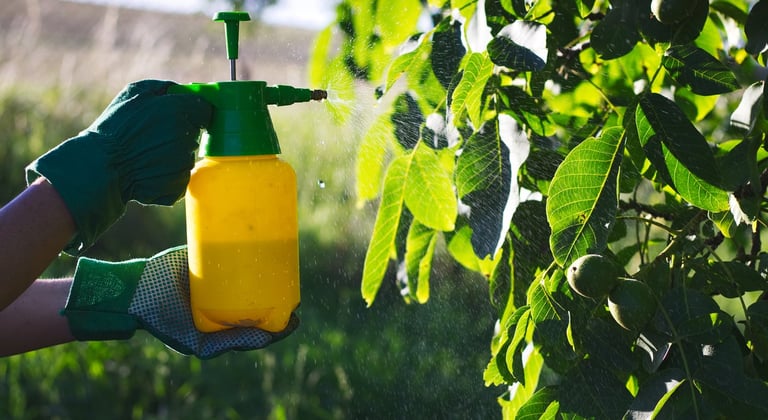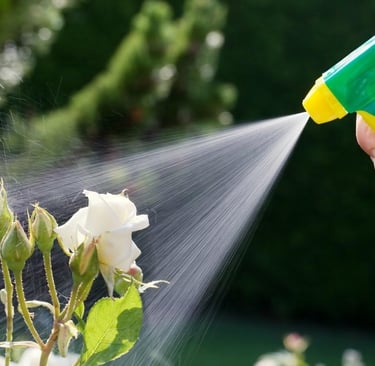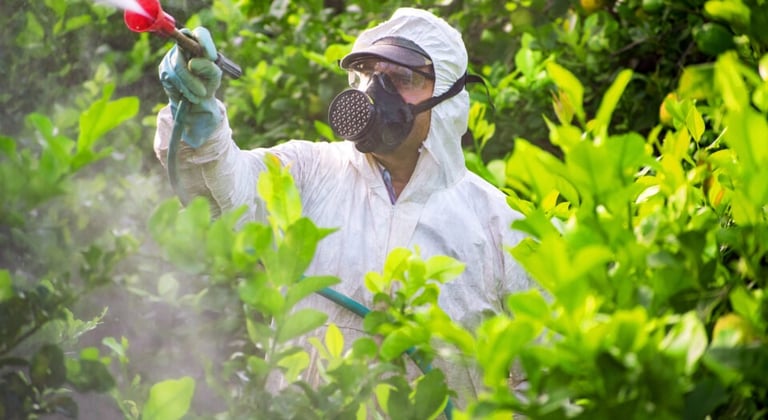Pesticides and Related Products: Protecting Plants and Enhancing Yields
Introduction
In modern agriculture and gardening, managing pests, diseases, and
weeds is crucial for achieving optimal plant health and high yields.
Pesticides and their related products—fungicides, herbicides, and
insecticides—play a key role in safeguarding crops and gardens
from various threats. This page provides an in-depth look at
these products, including their types, uses, benefits, and important
safety considerations.


Fungicides/Herbicides/Insecticides/Pesticides
Fungicides: Combatting Fungal Diseases
What Are Fungicides?
Fungicides are chemical or biological agents used to prevent, control,
or eliminate fungal infections that affect plants. They are essential
for managing diseases caused by fungi, such as rusts, molds, and blights.
Types of Fungicides
Contact Fungicides
Description: These fungicides remain on the plant surface and prevent fungal spores from germinating.
Examples: Copper-based fungicides, sulfur.
Advantages: Effective against surface fungal infections.
Considerations: Must be applied regularly and thoroughly.
Systemic Fungicides
Description: Absorbed by the plant and transported through its tissues, providing internal protection against fungi.
Examples: Triazoles, strobilurins.
Advantages: Provides protection from within the plant.
Considerations: Generally more expensive and may have resistance issues.
Biological Fungicides
Description: Derived from natural organisms or compounds that inhibit fungal growth.
Examples: Bacillus subtilis, Trichoderma species.
Advantages: Environmentally friendly and safe for beneficial organisms.
Considerations: May require specific conditions to be effective.
Uses and Applications
Crops: Wheat, corn, grapes, tomatoes, etc.
Gardens: Vegetables, fruits, ornamental plants.
Application Methods: Spraying, soil drenching, and seed treatment.
Benefits
Disease Control: Prevents and manages fungal diseases, protecting plant health and yield.
Enhanced Crop Quality: Reduces fungal damage, leading to better quality produce.
Safety Considerations
Follow Label Instructions: Use as directed to avoid harm to plants and humans.
Protective Gear: Wear gloves, masks, and protective clothing during application.
Fungicides


Herbicides: A Comprehensive Guide
Herbicides are chemicals used to manage and control unwanted plants,
commonly referred to as weeds. They play a crucial role in agriculture,
landscaping, and weed management by targeting specific types
of plants while minimizing harm to desired crops or vegetation.
Understanding the different types of herbicides and their
applications can help ensure effective and safe weed control.
Types of Herbicides
Herbicides can be classified based on their chemical structure, mode of action, and spectrum of activity. Here’s an overview of the primary categories:
1. Selective Herbicides
Selective herbicides target specific types of weeds without harming the desired plants. They are used in agricultural settings where certain crops need protection from weeds. Selectivity is achieved through the herbicide’s specific action on certain physiological processes or through differential absorption by the plants.
Example: 2,4-D is commonly used to control broadleaf weeds in grass crops without damaging the grass.
2. Non-Selective Herbicides
Non-selective herbicides, also known as total herbicides, kill or damage all types of plants they come into contact with. They are used for clearing areas of vegetation, such as during land preparation or in areas where complete vegetation removal is required.
Example: Glyphosate is widely used for its effectiveness in killing a broad range of weeds and is often used in conjunction with genetically modified crops that are resistant to it.
3. Pre-Emergent Herbicides
Pre-emergent herbicides are applied before the weeds germinate. They work by creating a barrier in the soil that prevents weed seeds from sprouting or establishing.
Example: Pendimethalin is used to control weeds in lawns and crops by inhibiting seed germination.
4. Post-Emergent Herbicides
Post-emergent herbicides are applied after the weeds have emerged and are actively growing. They target existing weeds and are effective when applied at the right growth stage.
Example: Dicamba is used to control broadleaf weeds that are already growing among crops.
5. Systemic Herbicides
Systemic herbicides are absorbed by the plant and translocated throughout its tissues. These herbicides kill the entire plant, including the root system.
Example: Roundup (glyphosate) is a systemic herbicide that affects the entire plant, making it effective for long-term weed control.
6. Contact Herbicides
Contact herbicides kill only the parts of the plant they touch. They are not translocated through the plant, so multiple applications may be necessary for complete control.
Example: Paraquat is a contact herbicide that is effective in rapidly killing green plant tissues upon contact.
Application Methods
Herbicides can be applied using various methods depending on the type of herbicide and the target area:
Foliar Application: Spraying herbicides directly onto the leaves of weeds.
Soil Application: Applying herbicides to the soil where they are absorbed and act on weed seeds or seedlings.
Injection: Injecting herbicides directly into the plant for targeted control.
Safety and Environmental Considerations
Proper handling and application of herbicides are essential to minimize potential risks to humans, animals, and the environment. Key safety considerations include:
Personal Protective Equipment (PPE): Always wear appropriate PPE, such as gloves, masks, and protective clothing.
Proper Storage: Store herbicides in a secure location away from children and pets.
Follow Instructions: Adhere to label instructions for dosage, application methods, and safety precautions.
Environmental Impact: Be aware of potential impacts on non-target plants, wildlife, and water sources. Use herbicides responsibly to avoid contamination.
Conclusion
Herbicides are powerful tools for managing weeds and optimizing crop production. By understanding the various types of herbicides and their appropriate applications, you can effectively control unwanted vegetation while minimizing negative impacts. Always prioritize safety and environmental stewardship when using herbicides.
For more information or guidance on selecting the right herbicide for your needs, consult with agricultural extension services or a professional in weed management.
Herbicides


Insecticides


Insecticides: Types, Uses, and Best Practices
Insecticides are chemicals designed to manage and control insect pests that
can damage crops, gardens, and indoor environments. By understanding
the various types of insecticides and their applications, you can effectively
protect your plants and property while minimizing harm to beneficial insects
and the environment.
What Are Insecticides?
Insecticides are specialized chemicals used to kill or repel insects. They are crucial in agriculture for protecting crops, in homes for pest control, and in various other settings where insects pose a problem. Insecticides work through different mechanisms to disrupt the life processes of insects, leading to their control or eradication.
Types of Insecticides
Insecticides can be classified based on their chemical composition, mode of action, and target insects. Here’s an overview of the main types:
1. Contact Insecticides
Contact insecticides kill insects upon direct contact. They are applied to surfaces or plants where insects come into contact with them.
Use Case: Effective for quick knockdown of insects on treated surfaces or plants.
Example: Permethrin – A common contact insecticide used for managing pests on crops and in homes.
2. Systemic Insecticides
Systemic insecticides are absorbed by plants or animals and distributed throughout their tissues. Insects feeding on the treated plant or animal are affected by the insecticide.
Use Case: Ideal for controlling insects that feed on treated plants or animals.
Example: Imidacloprid – A systemic insecticide used in agriculture and veterinary medicine to manage a range of pests.
3. Residual Insecticides
Residual insecticides remain effective for an extended period after application. They form a lasting barrier that continues to kill or repel insects over time.
Use Case: Suitable for long-term pest control in both indoor and outdoor environments.
Example: Deltamethrin – Used in pest control for its long-lasting effects on surfaces.
4. Insect Growth Regulators (IGRs)
Insect Growth Regulators disrupt the normal development of insects, preventing them from maturing into adults or reproducing.
Use Case: Effective for managing populations by interfering with the growth and reproduction of pests.
Example: Methoprene – Used to control fleas and other pests by disrupting their life cycle.
5. Biological Insecticides
Biological insecticides use natural organisms or substances derived from them to control insect pests. They often target specific insect species and are considered environmentally friendly.
Use Case: Ideal for integrated pest management (IPM) strategies and reducing reliance on chemical insecticides.
Example: Bacillus thuringiensis (Bt) – A bacterial insecticide effective against caterpillars and other pests.
6. Organic Insecticides
Organic insecticides are derived from natural sources and are often used in organic farming and gardening. They are generally considered safer for humans, pets, and beneficial insects.
Use Case: Suitable for organic agriculture and environmentally-conscious pest control.
Example: Neem Oil – Derived from the neem tree, it acts as a repellent and disrupts insect feeding and reproduction.
Application Methods
The effectiveness of insecticides depends on the application method. Common methods include:
Spraying: Applying insecticides using a sprayer to target insects on plants or surfaces.
Drenching: Applying insecticides directly to the soil or plant base to control pests in the soil or roots.
Fogging: Using fogging equipment to disperse insecticides in the air for large-scale or indoor pest control.
Baiting: Placing insecticide-laden bait in areas where insects are active, allowing them to consume the insecticide.
Safety and Environmental Considerations
Using insecticides responsibly is essential for safety and minimizing environmental impact. Key considerations include:
Personal Protective Equipment (PPE): Wear appropriate PPE, such as gloves, masks, and protective clothing, as recommended on the insecticide label.
Proper Storage: Store insecticides in a secure, cool, and dry place, away from children, pets, and food products.
Follow Instructions: Adhere to label instructions regarding dosage, application methods, and safety precautions.
Environmental Impact: Be aware of potential effects on non-target insects, wildlife, and water sources. Use insecticides judiciously to avoid harm to beneficial insects and ecosystems.
Conclusion
Insecticides are powerful tools for managing insect pests and protecting plants and property. By understanding the different types of insecticides and their appropriate uses, you can achieve effective pest control while maintaining safety and environmental responsibility. For tailored advice or assistance with insecticide selection and application, consult with pest management professionals or local agricultural extension services.
Pesticides


Pesticides: Types, Uses, and Best Practices
Pesticides are essential tools in agriculture, gardening, and pest control, designed
to manage and eliminate pests that can damage crops, plants, and property.
By understanding the different types of pesticides and their applications,
you can effectively manage pests while minimizing risks to human health,
beneficial organisms, and the environment.
What Are Pesticides?
Pesticides are chemicals or biological agents used to control or eliminate pests,
including insects, weeds, fungi, and rodents. They play a critical role in
protecting crops and maintaining healthy landscapes. Pesticides work
through various mechanisms to disrupt the life processes of pests, leading to their control or eradication.
Types of Pesticides
Pesticides can be categorized based on the types of pests they target, their chemical composition, and their mode of action. Here’s an overview of the main types:
1. Insecticides
Insecticides are used to control insect pests that can damage crops, gardens, and homes. They work by disrupting the nervous system or other physiological processes of insects.
Types:
Contact Insecticides: Kill insects upon direct contact (e.g., Permethrin).
Systemic Insecticides: Absorbed by plants or animals, affecting insects that feed on them (e.g., Imidacloprid).
Biological Insecticides: Use natural organisms or substances (e.g., Bacillus thuringiensis).
2. Herbicides
Herbicides target and kill unwanted plants, commonly known as weeds, that compete with crops for resources. They can be selective or non-selective.
Types:
Selective Herbicides: Target specific weed types without harming desired plants (e.g., 2,4-D).
Non-Selective Herbicides: Kill all plants they come into contact with (e.g., Glyphosate).
Pre-Emergent Herbicides: Prevent weed seed germination (e.g., Pendimethalin).
Post-Emergent Herbicides: Control existing weeds (e.g., Dicamba).
3. Fungicides
Fungicides are used to prevent and control fungal diseases that affect plants, such as mildew, rust, and blight. They work by inhibiting the growth or reproduction of fungi.
Types:
Systemic Fungicides: Absorbed and transported within the plant to provide internal protection (e.g., Triazoles).
Contact Fungicides: Act on the surface of the plant to prevent fungal infection (e.g., Chlorothalonil).
4. Rodenticides
Rodenticides are used to control rodent pests such as rats and mice, which can damage property and spread disease. They work by disrupting the rodent’s biological processes.
Types:
Anticoagulant Rodenticides: Cause internal bleeding (e.g., Brodifacoum).
Non-Anticoagulant Rodenticides: Work through different mechanisms, such as disrupting metabolism (e.g., Bromethalin).
5. Nematicides
Nematicides are used to control nematodes, which are microscopic worms that can damage plant roots and reduce crop yields.
Types:
Chemical Nematicides: Applied to the soil to target nematodes (e.g., Methyl Bromide).
Biological Nematicides: Use natural organisms or substances to control nematodes (e.g., Pasteuria penetrans).
Application Methods
The effectiveness of pesticides depends on the application method. Common methods include:
Spraying: Using a sprayer to apply pesticides directly onto plants or surfaces.
Drenching: Applying pesticides to the soil or plant base to target soil-borne pests or diseases.
Injection: Injecting pesticides directly into the plant or soil for targeted treatment.
Baiting: Placing pesticide-laden bait where pests are active, allowing them to consume the pesticide.
Safety and Environmental Considerations
Responsible use of pesticides is essential for protecting human health, beneficial organisms, and the environment. Key considerations include:
Personal Protective Equipment (PPE): Always use appropriate PPE, such as gloves, masks, and protective clothing, as specified on the pesticide label.
Proper Storage: Store pesticides in a secure, cool, and dry place, away from children, pets, and food products.
Follow Instructions: Adhere to the label instructions regarding dosage, application methods, and safety precautions.
Environmental Impact: Be mindful of potential effects on non-target organisms, wildlife, and water sources. Use integrated pest management (IPM) practices to minimize environmental impact.
Conclusion
Pesticides are vital tools for managing pests and protecting crops and property. By understanding the different types of pesticides and their appropriate uses, you can achieve effective pest control while maintaining safety and environmental responsibility. For tailored advice or assistance with pesticide selection and application, consult with pest management professionals or local agricultural extension services.
About Agri Agro Grand Expo
Agri Agro Grand Expo International has served as a platform for bringing together many foreign as well as national visitors from all over the country to interact with leading national agriculture technology companies. The Agriculture Expo, held annually, is one of the leading national agriculture events of its kind, showcasing cutting-edge agricultural technologies. This exhibition in India traditionally attracts numerous Ministers of Agriculture, decision-makers, experts, practitioners, and trainers in agriculture, along with thousands of visitors from around the country.
contact :
expo@agriagro.in
exposulabh@agriagro.in
+91-9520099666
+91 -70601 71734
+91 -8791144200
© 2026 Agri Agro Grand Expo All rights reserved.
Mail:
